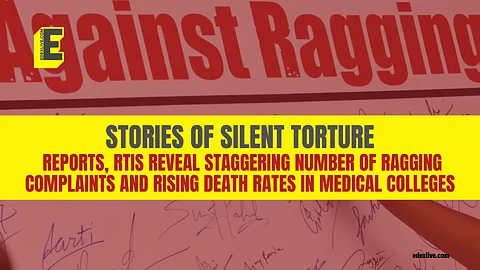

Ragging in Indian medical colleges has now reached an alarming level, as revealed in these recent findings from a Right to Information (RTI) query filed by Dr Lakshya Mittal, President of United Doctors' Front (UDF), and a detailed report by the Society Against Violence in Education (SAVE).
These sources collectively highlight the severity of the issue and the systemic failure that paints a grim picture of the situation of medical students, both undergraduate (UG) and postgraduate (PG).
UDF RTI findings: 88 complaints from postgraduate students, minimal action taken
An RTI query filed by Dr Mittal on February 24, 2025, revealed that between January 2023 and January 2025, the National Medical Commission (NMC) recorded 88 instances of ragging from postgraduate (PG) students in medical colleges across India.
These states are the hotspots:
1) Uttar Pradesh: 13 complaints
2) Bihar/Odisha: 10 complaints
3) Maharashtra: 8 complaints
4) Tamil Nadu: 7 complaints
These states accounted for over 60% of the total complaints over two years. Other states, such as Andhra Pradesh, Gujarat, Rajasthan, Haryana, and Jharkhand, also reported complaints of ragging.
The data further shows the rise in the number of complaints every year.
- In 2023, 31 complaints were registered, which increased to 42 in 2024.
- In January 2025, 15 complaints have been registered so far.
NMC taking it not-so seriously?
The RTI further revealed how such matters were addressed by the respective colleges, ragging cells, and the NMC.
Despite the rising numbers, the response from the authorities can be deemed inadequate. In most cases, the NMC and the Anti-Ragging committees of the respective colleges closed complaints and declared that there may not have been any incidents of ragging.
For example, at MKCG Medical College, Berhampur, a complaint by a Junior Resident (JR)-1 was dismissed by the NMC ragging committee, stating there was “no incident of ragging.” However, as per reports, the college has reported 25 ragging complaints in three years, till December 2024.
In several other cases, such as in JNM Medical College in Wardha, Maharashtra, and DY Patil Foundation Medical College in Pune, the authorities were simply asked to "cooperate with students to complete their course."
"While a few colleges suspended students or were asked to cooperate with the victims, no significant penalties were imposed on institutions for failing to prevent such incidents. The lack of stringent measures has raised questions about the seriousness of anti-ragging enforcement and protection for junior doctors in private institutions," said Dr Lakshya Mittal in a statement.
Ragging-related deaths in medical colleges stand at 45.1%
Complementing the RTI findings, let's have a look at the findings stated in a report published this year, by the Society Against Violence in Education (SAVE), a non-profit organisation, working toward eradicating cases of ragging in educational institutions across India.
Based on 3,156 complaints registered with the National Anti-Ragging Helpline across 1,946 colleges, the report reveals that medical colleges are severely affected, accounting for:
- 38.6% of total ragging complaints
- 45.1% ragging-related deaths, despite medical students comprising only 1.1% of India's student population
The SAVE report identified these medical colleges as hotspots for ragging (2022-24):
- MKCG Medical College and Hospital in Brahmapur, Odisha: 25 complaints
- Pt Jawahar Lal Nehru Memorial Medical College in Raipur, Chhattisgarh: 15 complaints
- Vardhman Institute of Medical Sciences in Pavapuri, Bihar: 14 complaints
- State Takmeel-Ut-Tib College and Hospital in Lucknow, Uttar Pradesh: 12 complaints
- Maulana Azad Medical College, New Delhi/ Patna Medical College and Hospital, Bihar: 11 complaints
And these medical universities (2022-24):
- Madhya Pradesh Medical Science University, Jabalpur: 75 complaints
- Atal Bihari Vajpayee Medical University, Lucknow, Uttar Pradesh: 68 complaints
- Maharashtra University of Health Sciences, Nashik, Maharashtra: 61 complaints
- Rajasthan University of Health Sciences, Jaipur, Rajasthan: 52 complaints
- West Bengal University of Health Sciences, Kolkata, West Bengal: 39 complaints
An alarming conclusion that was deduced from the report was that
- Medical colleges accounted for 23 out of 51 ragging-related deaths between 2022 and 2024.
- In 2024 alone, 20 deaths were reported, surpassing the number of student suicides in Kota in the same year (20 deaths).
These underscore the dire situation that results in students' deaths due to unchecked ragging.
According to Gaurav Singhal, anti-ragging activist and Vice-President of SAVE, the highest number of cases were reported from government medical colleges, and the reason, he stated, was the lack of accountability.
"Most government colleges fail to treat such cases with the seriousness they deserve. There is a 'sarkari babu' culture in these institutions," he noted, the inaction and nonchalant attitude towards these cases rising from the security of government job positions.
He further said, "There's chaos in such medical colleges. Even with ragging cases being reported, the government medical colleges fail to respond promptly. They do not even bother with such cases, as their admission rates and reputation remain unaffected. That's the security they have," he claims.
Singhal also places the onus on the Ministry of Health and Family Welfare (MoHFW), which has failed, so far, in devising rational solutions to curb the suicide rate in medical institutions.
Citing a case that occurred in November last year at the Bhilwara Medical College, Rajasthan, affiliated with the Rajasthan University of Health Sciences (RUHS), Singhal said that students were sexually ragged. When complaints were filed, he said, that the principal blatantly denied the incident, even though there were several witnesses to the ragging.
As per reports, there has been no action taken against the college principal or the concerned authorities.
Is it high time for the NMC and the MoHFW to treat ragging as an educational crisis, also ensuring the safety of India’s doctors?
What do you think of it? Let us know in the comments section.
